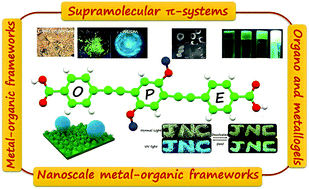Self-assembled organic and hybrid materials derived from oligo-(p-phenyleneethynylenes)
Abstract
Oligo-(p-Phenyleneethynylenes) (OPEs) have garnered widespread interest over the past three decades due to their excellent opto-electronic properties. However, the chief focus has been on the use of mainly small molecules or polymeric systems for the study of their structural diversity in opto-electronic applications. Recently, researchers have started delving deeper into their utility in material applications. Purely organic materials such as supramolecular polymers, self-assembled nanostructures, nanostructured organogels and single-crystalline materials derived from OPEs have already been developed and researched. Chirality has also been introduced into these systems. Additionally, these have shown physical properties such as polymorphism, liquid crystallinity, melt formation, mechanochromism, etc. All these materials have also shown excellent luminescence properties with high quantum yield and some have even shown energy harvesting properties. There have also been sporadic reports on OPE linker based hybrid systems such as metallogels and metal–organic framework (MOF) structures where structural analysis reveals the origin of tunable emission in these materials. Furthermore, by innovative structural design, unexplored properties of OPEs such as water repellency, bioimaging, drug delivery, photocatalysis, energy transfer, nanomorphology control, photoconductivity, and colour tunability could be achieved. This feature article will, therefore, encompass a detailed discussion on the development of this field as well as the analysis of the properties realized in OPE derived self-assembled supramolecular materials. The main focus will be on the following classes of materials: soft supramolecular materials, crystalline supramolecular π-systems, nanoscale metal–organic frameworks (NMOFs) and bulk metal–organic frameworks (MOFs) and how their application horizon has been expanded by integrating OPEs into their structures.

- This article is part of the themed collection: Chemical Communications HOT Articles 2022


 Please wait while we load your content...
Please wait while we load your content...